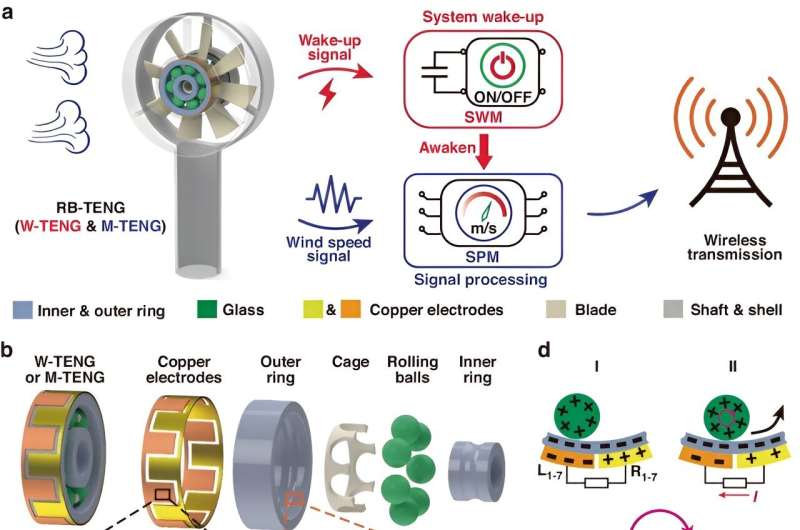This article has been reviewed according to Science X's editorial process and policies. Editors have highlighted the following attributes while ensuring the content's credibility:
fact-checked
peer-reviewed publication
trusted source
proofread
New wind speed sensor uses minimal power for advanced weather tracking

Researchers have unveiled a pioneering breeze wake-up anemometer (B-WA), employing a rolling-bearing triboelectric nanogenerator (RB-TENG) that provides a new strategy for low-energy consumption environmental monitoring. The ability of the B-WA to operate autonomously and efficiently in varying wind conditions marks a substantial advancement in the field of sustainable environmental monitoring.
Anemometers are crucial tools for collecting meteorological data, essential for accurate weather forecasting and environmental monitoring. Traditional anemometers often face challenges related to high maintenance and operational costs, primarily due to their high quiescent power consumption and reliance on battery power. These challenges are particularly acute in remote locations where replacing batteries or repairing equipment is difficult and expensive.
The introduction of low-power self-waking-up anemometers can transform environmental monitoring by enabling longer deployment periods, reducing the frequency of maintenance, and enhancing the reliability of data collection in these critical but hard-to-reach areas.
A new study published in Microsystems & Nanoengineering by a team from the Beijing Institute of Nanoenergy and Nanosystems describes a Breeze Wake-up Anemometer (B-WA) designed to dramatically enhance remote weather monitoring capabilities.
The newly developed B-WA integrates the following key components: two rolling-bearing triboelectric nanogenerators (RB-TENGs), a self-waking-up module (SWM) and a signal processing module (SPM). B-WA can remain in a near-zero power quiescent state until activated by wind speeds exceeding 2 m/s. The RB-TENG is engineered to generate power from the motion of rolling bearings, which is harnessed to wake the device from its low-power state.
Upon activation, the SWM can wake up the entire system within just 0.96 seconds, enabling real-time wind speed measurement. Concurrently, the SPM processes the frequency of the signals generated by the RB-TENG to accurately monitor wind speed with a sensitivity of 9.45 Hz/(m/s), ensuring precise and reliable data collection.
Prof. Chi Zhang, the project's lead scientist, stated, "This device not only pushes the boundaries of nanotechnology but also offers a sustainable solution to global weather monitoring challenges. Its low-energy requirement and high sensitivity are crucial for the future of environmental sensing."
This technology is pivotal for areas like agricultural planning and natural disaster prevention, where accurate and timely weather information can significantly impact decision-making and operational safety. The B-WA's robust and low-maintenance design makes it ideal for integrating into Internet of Things (IoT) networks, enhancing distributed environmental monitoring across various sectors.
More information: Xianpeng Fu et al, A near-zero quiescent power breeze wake-up anemometer based on a rolling-bearing triboelectric nanogenerator, Microsystems & Nanoengineering (2024). DOI: 10.1038/s41378-024-00676-7
Journal information: Microsystems and Nanoengineering
Provided by Chinese Academy of Sciences




















